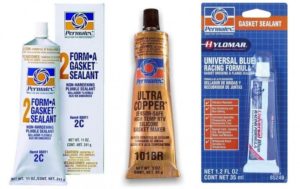Tech 101 – How to use the right gasket sealants (blog.hemmings.com)

With the varied composition of gaskets available on the market today, it is important that you use the proper sealant to ensure the gaskets seal effectively and not adversely affect the gaskets’ longevity. In many cases, using the correct sealant will actually extend the life of the gasket because it offers protection from engine heat as well as resistance to corrosive chemicals found in oils, fuels and other fluids that can cause the gasket to deteriorate over time.
There are literally thousands of sealants available on today’s market, and we are not recommending one brand over another, but certainly Permatex is an industry leader, and many of the product characteristics for each type of sealant reflect equivalency to the Permatex standards, so we will use their standards as a guide.
A careful examination of what each category of sealants does and doesn’t do should point you in the right direction when deciding which type of sealant you should use. Here are just a few of the basic groups of sealants enthusiasts should have on hand when tackling an engine, transmission, differential or minor repair.
Shellac – Often referred to as Indian Head after the Permatex product. Shellac is ideal for thin paper or cardboard gaskets that are mounted in a low temperature and/or low pressure environment. It should not be used in temperatures higher than 300 to 350 degrees. Resistant to engine fluids, its most common uses are in mounting thermostat, timing cover or differential cover gaskets. They are not resistant to many shop chemicals, thankfully, because they can be a real bear to clean off, if necessary in the future.
High Tack – Available in brush-top bottle or in tubes, High Tack is a non-drying gasket sealant that can be used in similar applications to shellac, but can sustain temperatures of up to 500 degrees. It remains tacky and also resists kerosene, propane and diesel fuels.
Form-a-gasket sealers – These are available in several types: fast drying, fast hardening (usually called #1); slow drying, non-hardening (usually called #2); brushable slow drying, non-hardening (usually referred to as aviation or #3). All three form-a-gasket sealers are rated to 400 degrees, but each serves a slightly different purpose. Number 1 is most often used in applications you hope to never have to deal with again. It is often used to install block expansion plugs, threaded connections and to seal between metal-to-metal flanges. Number 2 sealants work best on cork gaskets or paper oil pan gaskets. Because they are non-hardening, clean-up is much easier when resealing is eventually needed. They are often used on neoprene transmission pan gaskets as well. Aviation form-a-gasket has the advantage of being brushable, so you can lay on a thin or thick coat to seal metal flanges, machined surfaces and solid gaskets. It works well for sealing hose connections because it is fuel and oil-resistant. It is also non-hardening for ease of resealing.
Copper gasket sealant – Available both in brushable and in aerosol forms, copper gasket sealer is fast-drying, and the metal content suspended within the sealant helps to dissipate heat and promote even heat transfer between the mating surfaces. It can also be used to fill small imperfections in the metal surfaces, promoting a more positive seal. Rated for up to 500 degrees, copper gasket sealant is best suited for cylinder head and exhaust manifold gaskets. It is also very easy to clean, even after extended periods of time.
Anaerobic sealers – Usually in a tube and red in color, anaerobic sealers are designed to be used in applications where outside air is not available to help the drying process. They were created to meet OE manufacturers’ requirements for a non-corrosive gasket maker in metal-to-metal applications. Anaerobic sealers are good for side-of-the-road leak repairs or for places where there never has been a gasket or the replacement gasket is no longer available. Anaerobic sealers will also fill small imperfections in mating surfaces.
RTV Silicone Sealers – Available in about a dozen different colors and spreadable via tubes, aerosol cheese-whiz-type cans or even in caulk-gun cartridges, Room Temperature Volatile silicone is effective as a gasket sealer as well as a gasket by itself. Temperature ratings and individual properties are available on a chart on the Permatex website. Basically, for applications up to 500 degrees, blue, black and grey are recommended. For up to 650 degrees, orange or red are recommended, and copper is good for temperatures up to 750 degrees. Whenever faced with a choice between a conventional RTV and an “Ultra” RTV, you should also consider that the Ultra products are sensor-safe for newer electronic-controlled vehicles.
Hylomar – This is a relatively new product in the aftermarket but has been used by many OE manufacturers for almost 30 years. It is a polyester urethane-based gasket compound that withstands temperatures of up to 500 degrees without hardening. It’s non-setting and remains tacky, making repeated disassembly and re-assembly much easier for racing applications where constant adjustments under the hood are necessary. It can be used as a gasket sealer or in place of a gasket. Hylomar could very well be the adjustable wrench of gasket sealers, fit for any do-it-yourself or professional tool box.
